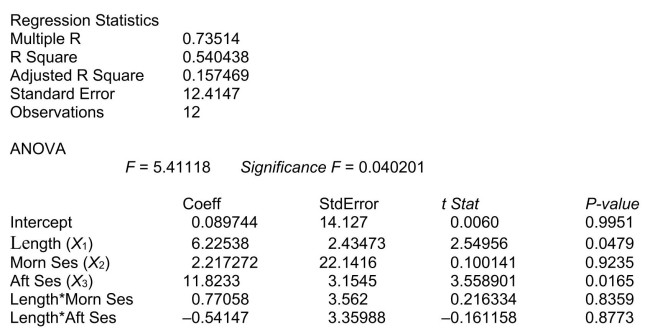SCENARIO 18-6 A weight-loss clinic wants to use regression analysis to build a model for weight-loss of a client (measured in pounds) .Two variables thought to affect weight-loss are client's length of time on the weight loss program and time of session.These variables are described below: Y = Weight-loss (in pounds)  = Length of time in weight-loss program (in months)
= Length of time in weight-loss program (in months)  = 1 if morning session, 0 if not
= 1 if morning session, 0 if not  = 1 if afternoon session, 0 if not (Base level = evening session) Data for 12 clients on a weight-loss program at the clinic were collected and used to fit the interaction model:
= 1 if afternoon session, 0 if not (Base level = evening session) Data for 12 clients on a weight-loss program at the clinic were collected and used to fit the interaction model:  Partial output from Microsoft Excel follows:
Partial output from Microsoft Excel follows: 
-Referring to Scenario 18-6, which of the following statements is supported by the analysis shown?
Definitions:
Maturity Factoring
A financing method where a business sells its invoices to a factor at a discount but receives payment only when the customer pays the invoice at maturity.
Factoring
A financial transaction where a business sells its accounts receivable to a third party at a discount to raise immediate capital.
Inventory
A company's stock of the products available for sale to customers, as well as raw materials and work-in-progress that will eventually become finished goods.
Accounts Receivable
Funds that are due to a business from its clients for goods or services already provided but not yet compensated for.
Q3: Referring to Scenario 16-13, what is the
Q4: Referring to Scenario 15-6, the model that
Q17: Referring to Scenario 18-10 and using both
Q28: In selecting a forecasting model, you should
Q50: Referring to Scenario 19-9, an <img src="https://d2lvgg3v3hfg70.cloudfront.net/TB8562/.jpg"
Q63: Which of the following is NOT among
Q94: Referring to Scenario 16-4, a centered 5-year
Q103: Referring to Scenario 18-12, there is not
Q103: Referring to Scenario 20-6, what is the
Q213: Referring to Scenario 18-6, what null hypothesis